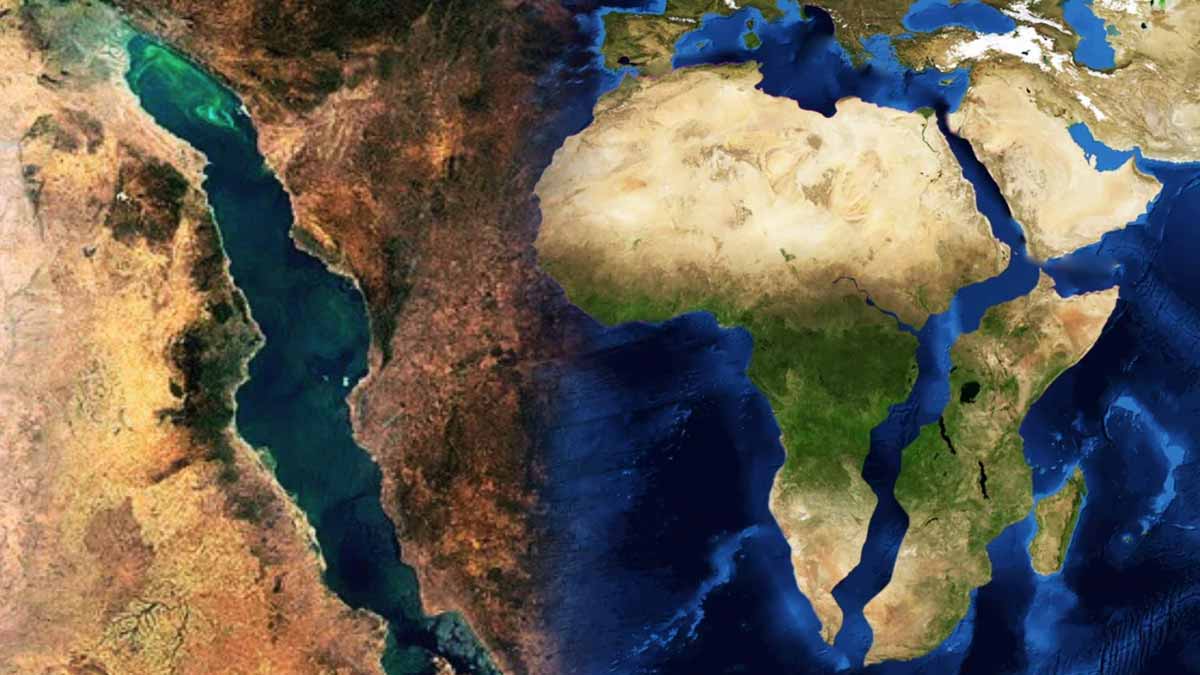A crack in Earth’s skin is widening, and with it comes a future ocean that could redraw maps and markets. Along the East African Rift System, faults stretch from Mozambique to the Red Sea while forces below thin and warm the crust. Scientists now point to a shorter timeline, so expectations shift fast, and plans around people, nature, and trade will need to follow.
Rift on the move across a living continent
East Africa sits on a boundary where the African and Somali plates pull apart. Their motion averages about 0.8 centimeters each year, a slow rate that still stores strain for release in bursts. In Ethiopia’s desert, a rift segment runs roughly 60 kilometers and drops about 10 meters, a clear mark of extension that exposes hot rock, new fractures, and shifting groundwater.
Magma intrudes as plates separate, lifting some blocks while others sink. That circulation opens paths for fluids and gas, alters springs, and drives ground deformation that locals notice first. Scientists log these changes with field surveys and compare them to satellite scenes to map where surfaces tear and where subsidence threatens roads, pipes, and homes.
Over geologic time, extension widens and deepens a basin until seawater can enter. As crust thins, denser rock forms beneath and buoyancy falls. When a narrow seaway finally links to the coast, currents and sediment rapidly reshape river mouths, deltas, and wetlands that sit at today’s shoreline.
How a new ocean begins inside solid ground
Rifting starts when heat and stress weaken thick continental crust. Fractures lengthen, link, and fill with magma that pries blocks apart. Because heat lowers rock strength, each intrusion makes the next easier, so the process can accelerate even while average motion remains steady on yearly charts.
Geologists compare these steps to the Atlantic’s birth, where ancient margins preserve a sequence from lakes to straits to broad seaways. As sediments settled, mid-ocean ridges rose, and magnetic stripes formed when cooling lava recorded Earth’s field. Those frozen bands later revealed spreading rates and the tempo of crust creation.
Today, GPS tracks millimeters of motion, radar maps uplift and subsidence, and dense seismic arrays trace magma dikes moving underground. Continuous monitoring captures short episodes that older campaigns missed. With those data, teams refine hazard maps, place instruments where they matter most, and test models against fresh events.
Daily life, economies, and nature in the rift’s shadow
Emerging shorelines could reshape trade if landlocked nations such as Zambia and Uganda gain access to deepwater routes. New ports would cut freight costs, shift logistics hubs, and attract processing zones tied to fisheries and minerals. These opportunities also raise questions about who pays, who benefits, and how corridors protect communities along the way.
As salty water floods lowlands, ecosystems change fast. Mangroves and seagrass may colonize protected bays, while inland farms adapt to altered water tables and soil salinity. Early ecological mapping helps planners steer infrastructure away from nurseries and migration routes, so biodiversity can persist while towns and industries expand.
Seismic risk is already present. Earthquakes, ground cracking, and landslides can damage roads, pipelines, and buildings long before seawater arrives. Practical defenses include flexible joints, reinforced foundations, routine drills, and clear signage. Early warnings buy time; with time, emergency services stay coordinated, supply chains restart sooner, and families return home safely.
Timelines, shocks, and what this ocean future demands
Tectonic change once seemed locked to tens of millions of years, yet newer estimates place a first connection to the sea near one million years, perhaps less. That revision reflects combined satellite, seismic, and field evidence, plus the possibility that rare, large quakes can trigger step-changes along weak zones.
In 2005, Ethiopia’s Afar region delivered a sharp lesson. Over a few days, more than 420 earthquakes accompanied a magma surge that tore open a large fissure. Processes that usually span centuries unfolded at human speed, reminding planners that infrastructure and insurance must account for sudden, clustered shocks.
As models improve, uncertainty narrows. Teams integrate crustal thickness, heat flow, magma chemistry, and fault geometry, then validate results against new swarms and ground shifts. Because data volumes grow quickly, software and training must keep pace. The aim is practical: safer cities, resilient corridors, realistic premiums, and rules that reward risk reduction.
Science, technology, and local voices shaping safer choices
Sensors protect best when they prioritize clinics, bridges, reservoirs, and schools. A layered network blends permanent GPS, portable seismometers, and satellite coverage. Field crews co-design placements with residents, who know where cracks recur, which wells taste different after quakes, and which slopes fail during seasonal storms.
Education ties classrooms to field camps. Students learn to read the ground, handle instruments, and code clean tools that share results in plain language. Simple dashboards report risk levels, closures, and utility status. Agencies that explain methods and limits earn trust, which speeds coordinated action when alarms trigger at night or during storms.
Cooperation across borders turns local gains into regional safety. Shared standards let maps interlock and alerts travel fast. Industry plans routes and materials that flex rather than fail. Agriculture shifts crops as soils change. Tourism focuses on geosites that inform as they attract. Step by step, that path prepares people for a coming ocean.
Why this ocean birth reshapes Africa’s coming century
The rift’s story mixes patience and surprise: slow pull, sudden leaps, and numbers that guide choices—0.8 centimeters a year, a 60-kilometer tear, hundreds of quakes in days. As timelines compress, preparation gains value. With clear maps, strong codes, and informed communities, a new ocean becomes less a threat and more a change we are ready to meet.
